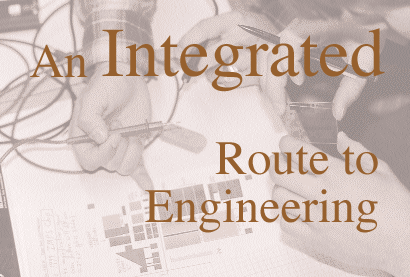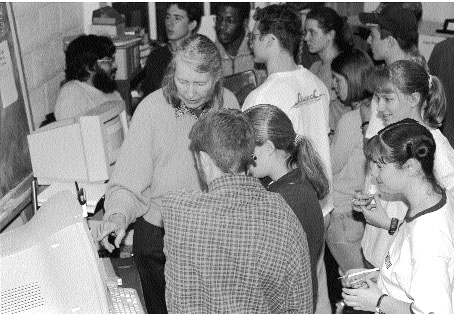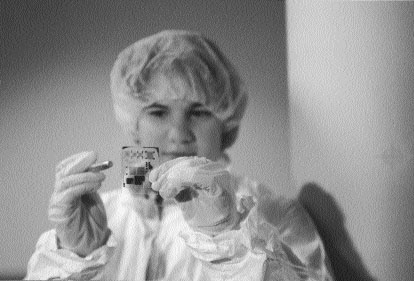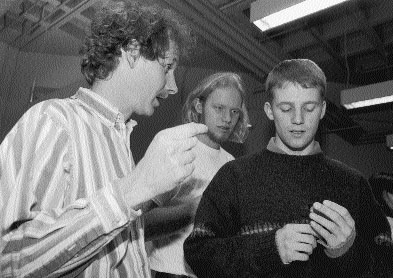DARTMOUTH COLLEGE SPRING 1999

PHOTOGRAPHY John Douglas
Ellen Frye
Thirty-eight Dartmouth freshmen are working check to jowl in Thayer School's microelectronics lab. Students have in hand "chips" they created the previous week by using photolithography to transfer one or more "mystery" devices onto 2" x 2" chrome-covered glass slides. Some patterns are electrical devices, some optical, but just what function any device might serve -- that's the mystery. Students have had a week to ponder.
Tonight the task is to use lab test equipment -- an alpha-step profilometer, for example, or a thermoelectric Peltier cooler -- to try out ideas and see whether functions that seem possible might actually work. Chris Levey, assistant professor of engineering who designed the lab, gives a brief overview of the equipment available and reminds students to refer to the mini-manuals that are part of their lab handout. Students go to work. Those who created electrical devices solder wires onto their contact pads to make better contact with the multimeter probes. Those who chose the optics route shine laser beams through their chips and measure aspects of the diffracted pattern thrown onto the wall. By 10 p.m., after the last computer is shut down, they have figured out potential applications for their chips -- from interdigitated electrode patterns used to sense dew points to a chirped optical grating that can function as a cylindrical lens. Some have sketched design changes for improvement.
THE IMPS APPROACH
Although a majority of the 38 students are heading toward engineering majors, this lab is not attached to an engineering course. They are in the final weeks of Dartmouth's Integrated Mathematics and Physics sequence (IMPS), an experimental two-term course that synchronizes topics in mathematics and physics so that each area of study supports the other.
Typically, although calculus instructors may select examples from physical science to illustrate techniques, and physics professors demonstrate mathematical models for natural phenomena, the actual order of topics for each course is determined without regard for the other. To a student, the cross-referencing may seem random. Even students with strong skills in mathematics and science can be hard put to effectively integrate what they know. Topics and techniques learned separately seem to be stored separately. Topics that are near duplicates of each other may be, in the student's mind, unrelated because they were learned without connectors.

PHOTOGRAPHY John Douglas
Professor Elsa Garmire was at the evening IMPS lab to talk with students about their binary optical devices.
IMPS, now in its third year, immerses students in mathematical concepts at the same time they learn about areas of physics to which the concepts can be applied. Both mathematics and physics syllabi have been reordered to synchronize physical phenomena and the mathematical models needed to describe and interpret them.
The course is definitely challenging. Students hit the ground running with first-order differential equations -- a topic not normally studied until the fourth term of the traditional calculus sequence. Why jump into differential equations? Because the first physics topic is an experimental approach to falling objects and, while you can make algebraic representations of experimental data, a thorough discussion requires the elegance and accuracy of differential equations.
IMPS students don't take Isaac Newton for granted. They drop objects, measure time and distance, and fit their empirical data to mathematical representations. They also study a variety of differential equations that are generalized from similar data, including different graphical representations such as direction fields or phase plane plots. By the end of their introduction to falling objects, IMPS students can pop a ping pong ball into the air and write an equation that represents the ball's motion very precisely, taking into account not just acceleration and the pull of gravity, but also the ball's mass and the electrical charge that propels it upward. Sure, an algebraic model could approximate the motion, but why not use mathematics the way physicists do? As the IMPS textbook states, "You need to be able to look at a physical problem and find a mathematical representation of that problem, and then yon need to be able to look at a mathematical result and see what it says about the original physical problem." [Mook, D.E. and M. Groszek: IMPS textbook, chapter 1, p 12]
Other first-term topics pair vector-valued functions with three-dimensional motion and second-order differential equations with harmonic motion. Winter-term topics include multivariable calculus applied to electricity and electromagnetism, and wave equations modeling optics. Throughout the course, students regularly tackle open-ended problems, problems for which neither the solution nor the appropriate method is readily apparent.
FORGING THE IMPS CURRICULUM
Under the umbrella of the NSF-sponsored
Math Across the Curriculum project (MATC),
IMPS has been developed jointly by faculty from
mathematics, physical sciences, and engineering. In its first two
years, it was a three-term course that included chemistry along with
mathematics and physics. Students and professors agreed that the
three-way coordination was difficult and the interfaces sometimes unclear,
so this year the course is a two-term mathematics-physics sequence.
Professors sit in on each others' classes to make sure the mesh is
seamless. IMPS faculty know they are in for a greater time commitment
than for other courses, but they value the interaction and getting to
know how each discipline uses the tools of the other.

PHOTOGRAPHY Joseph Mehling
In the IMPS microengineering lab, students use techniques borrowed from the microelectronics industry to etch micropatterns in chrome and glass. Erin Morse D'02 is using a laser pointer to examine the diffraction pattern produced by her "IMPS chip." As a WISP intern working with Professor Chris Levey, Erin was also involved in the design of this device; the etch pattern she specified is the two-dimensional Fourier transform of the desired bullseye diffraction pattern shown here. Looks like another engineer is on her way!When IMPS got under way, there was no plan for a textbook. During the first year, students used standard texts supplemented by a guide for coordinating nomenclature. Difficulties arose as students jumped around in texts designed for linearity. Even with the translation guide, language differences from one discipline to another were often real obstacles to comprehension.
Starting last year, faculty began developing units and placing them on the IMPS Internet site. This year those units, authored by Delo Mook, professor of physics, and Marcia Groszek, professor of mathematics, have jelled into an electronic textbook complete with animations. Although the units are not yet ready for wider dissemination and cannot be viewed by anyone outside the Dartmouth computer network, negotiations are underway with publishers. The hope is that the units will eventually be available in a flexible printed format with cross-references to the Internet version.
Textbook and course follow the current trend in mathematics and science education that "less is more." Rather than "covering" all topics in physics and calculus, the focus is on thorough explorations of selected concepts and techniques. Some traditionally "fundamental" topics don't appear at all while others are treated more than once. IMPS faculty believe that "seeing the same thing in a different way can often make the difference between understanding a topic and not understanding it." [Mook, D. E. and M. Groszek: The IMPS textbook, Introduction, p 2.] They also are confident that students who have a thorough understanding of what IMPS does cover will be able to consult other textbooks to learn topics omitted in the IMPS curriculum.

PHOTOGRAPHY John Douglas
Professor Chris Levey (left) is an enthusuastic advocate for the IMPS program. In 1996, at the very beginning of the program, he and Professor Ursi Gibson initiated a set of three labs for IMPS in the microengineering clean room.
CAMARADERIE IN A SUPPORTIVE ENVIRONMENT
This task of building relationships among topics and tackling complex multi-step problems takes place in a supportive environment. The physics department has dedicated the lab at 219 Wilder Hall to IMPS, and students use it as a combination lounge, study hall, and laboratory. Weekly tutorials provide assistance for anyone with homework difficulties, and TAs from both disciplines are available at almost any hour.
Eric Hansen, associate professor of engineering and co-investigator for the MATC project, points to the camaraderie that develops among IMPS students. "It's like being on a sports team," he says. "During their first two terms at Dartmouth, they spend at least two-thirds of their time going to classes, working on lab problems, and doing homework together." Marcia Groszek adds, "They get to know each other very well. They learn to work together in a way other students don't."
Indeed, friendships formed during the IMPS marathon often carry through the students' remaining years at Dartmouth. IMPS graduates who find themselves in the same classes continue their group study habits; some even end up rooming together. "It's one of the best parts of IMPS," says Dominic Germana D'O1, who took IMPS last year and is now an engineering major. "It was good to have integrated math and science and all, but the bonding of the class has been really great as far as developing a support group for future engineering classes."
Students enter IMPS from diverse backgrounds. Although enrollees must be familiar with elementary calculus, there is no physics prerequisite. The current crop of IMPS students range from some with Advanced Placement physics credit to a few who come from small schools where the physics lab is held together with duct tape. According to Allison Miller, physics TA for the course, you can't tell a student's background from the grade sheet. "They help each other," she says. Working together in informal study groups, students share both expertise and problems.
Miller also points to the supportive environment for women students. "It's a course that shatters stereotypes," she says. "It's good for students to work with women faculty members (three of the four instructors this year are women) and use a textbook that is co-authored by a woman."
FROM PRE-ENGINEERING TO ENGINEERING
Dartmouth is not the only undergraduate school experimenting with an integrated curriculum. In Indiana, Rose-Hulman Institute of Technology is part of a movement among engineering schools to integrate first-year mathematics, science, and engineering courses. That school has been joined in the restructuring effort by a coalition including Arizona State University, Texas A & M, and the University of Alabama, among others.
What are the outcomes of these experiments in integration? At Dartmouth, IMPS has a good record for retaining engineering majors. Last year, the 17 IMPS students who began the year leaning toward engineering all continued into the major and were, in fact, joined by five others who had come in undecided. "This increase is very important," says Dorothy Wallace, professor of mathematics and principal investigator for MATC. "One of the primary purposes of developing the course was to increase the number of engineering majors. In that it has been very successful."
Wallace acknowledges that the results of standardized tests or rankings of IMPS graduates by professors in later courses do not show a significant difference between IMPS students and those who take traditional mathematics and physics; she also points out that these statistics may be less meaningful in light of the fact that potential engineering majors often fall by the wayside in the traditional courses while those taking IMPS are more likely to go on, even if they find themselves in the bottom half of the class.
Students can be emphatic about the advantages of IMPS. Dean Rahman D'O1, who took IMPS last year and is now an engineering major, says that he found himself this year tutoring students who took the traditional track. "I can tell you that the fluidity and continuity the IMPS sequence provided -- and the other courses lacked -- was invaluable. Also the integration of math, physics, and chemistry solidified my understanding of concepts so that my learning efficiency multiplied." Angel Guarniz D'01, also an engineering major, is enthusiastic about how the mathematics was more than numbers. "With the real-life problems given to us," he says, "it took on a whole new meaning." Even Susan Ashlock D'OO, who took the course in its first rough-edged year and says frankly that it was frustrating being a "guinea pig," is quick to balance the frustrations with her easy transition into engineering courses. Describe circuitry using differential equations? No problem after IMPS.
WHAT'S AHEAD FOR IMPS
The NSF grant for MATC runs through next year, so IMPS has one more year to prove its value in the Dartmouth curriculum. With only 40 or so students, it doesn't offer real load relief for either the mathematics or the physics department. Faculty from both are supportive of its continuation as are Thayer School professors who see it as the preferred entry for engineering students. As more students pass through and talk about the confidence gained from working in teams and the value of strong relationships with fellow students and professors, word-of-mouth student marketing plus the strong support of Thayer School faculty will hopefully lead to an increase in enrollment and clear sustainability.
Whether or not the actual IMPS course remains in the Dartmouth curriculum after 2001, it's a sure bet its influence will continue. Professors who have worked together developing courses and a textbook have opened a window for dialogue. They've taken the extra time to sit in on each other's classes, they've learned how the concepts and techniques of each discipline can mesh into a whole. The window is not going to close. Future Dartmouth students -- and students from other schools who pick up the IMPS textbook -- will continue to discover some very dynamic connections between calculus, physics, and engineering.

![]()